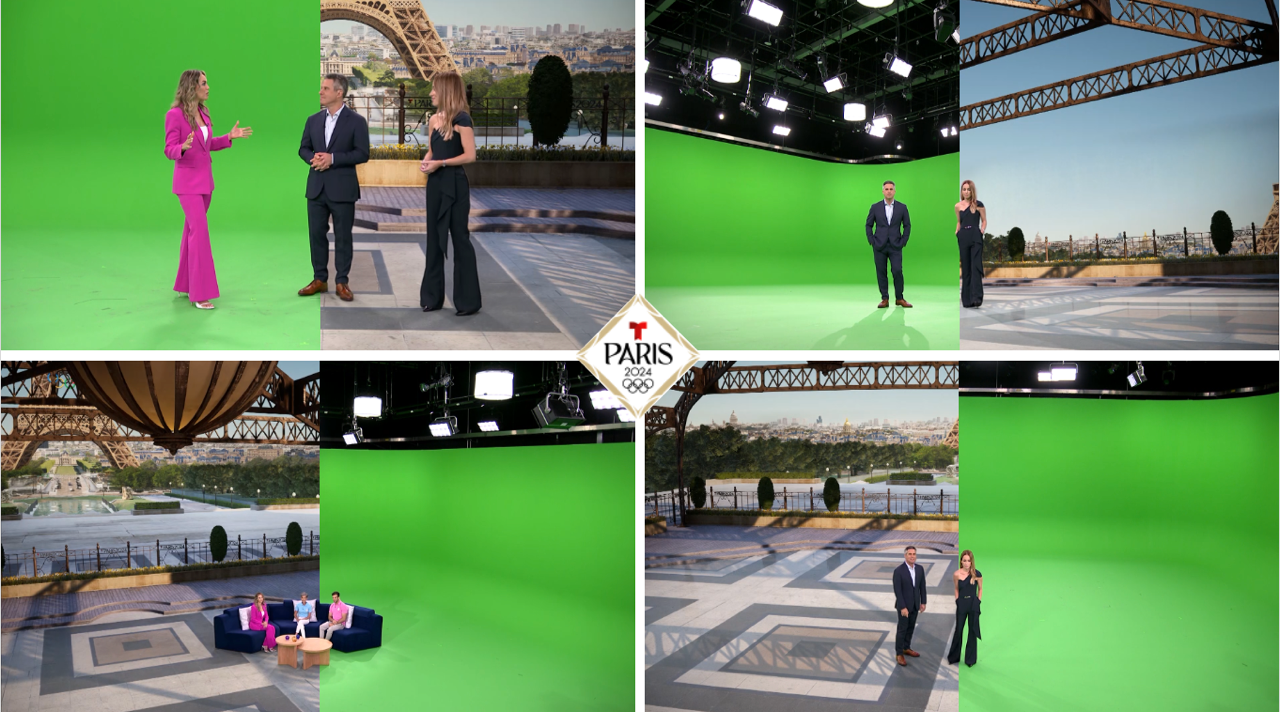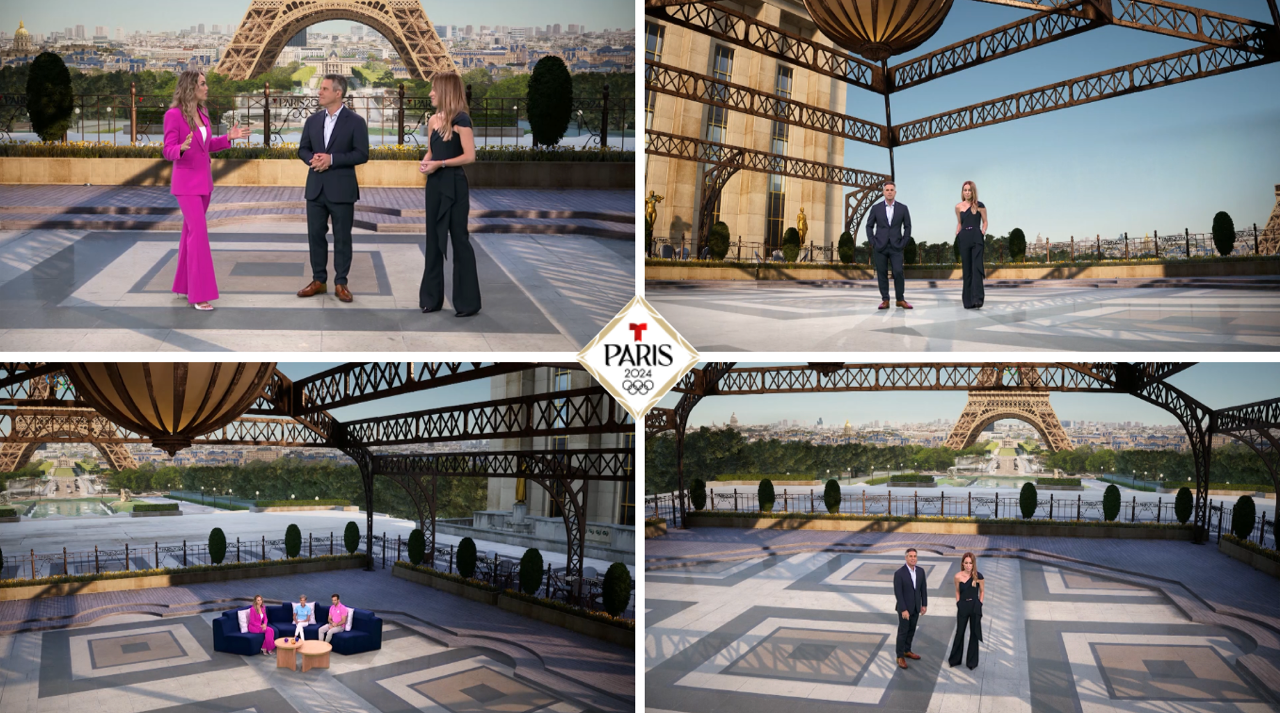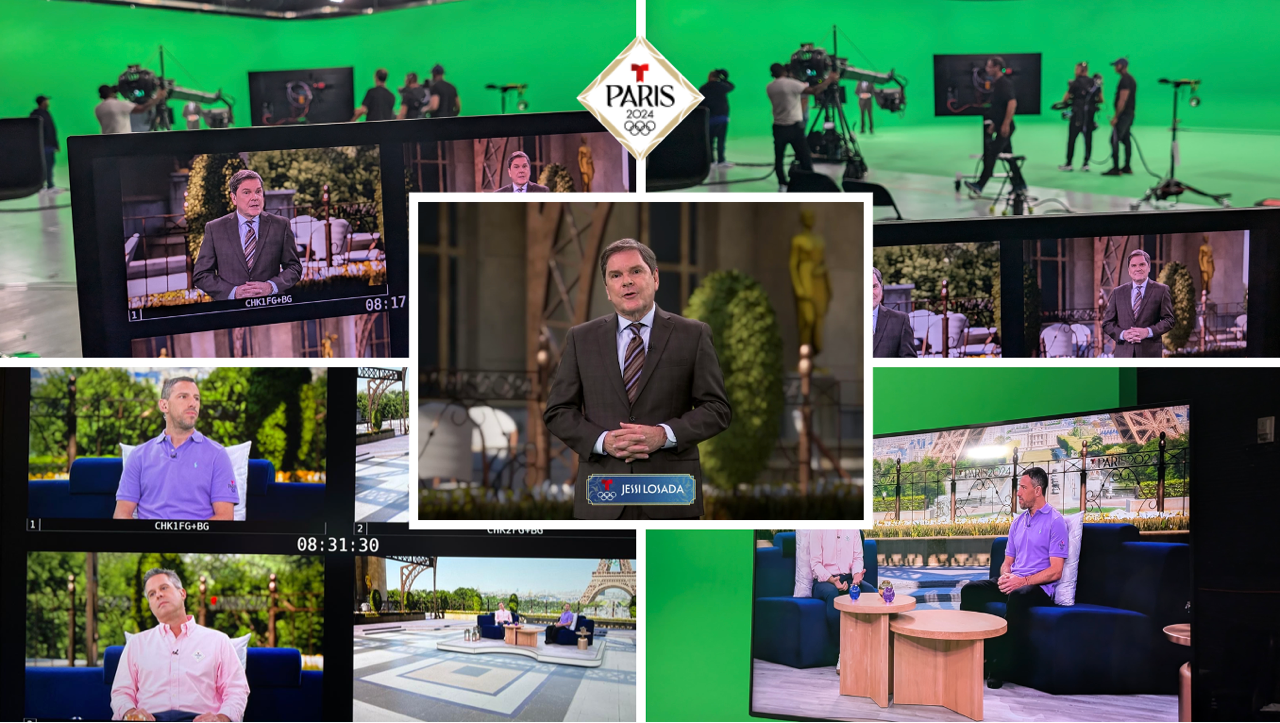Telemundo Takes VR Studio Tech from Miami to the Paris Olympics
Telemundo's virtual reality studio in Miami uses Unreal Engine and Chyron to provide a "photo-realistic look" that shows small details of the Paris landscape like the "wind in the trees"

MIAMI & PARIS —As the Paris Olympics games head into their final weekend, much of the tech talk has been about the use of AI technologies in the production of the games. But the games have also seen notable advances in a number of other areas, including virtual reality technologies and remote production solutions that have played an important role Telemundo’s Spanish-language coverage.
During this year’s coverage, Telemundo’s main studio has been a photorealistic virtual set in Miami that looks like it is in the Trocadero, offering a stunning view of the Eiffel Tower. This technology, which was used successfully in previous events like the 2020 Tokyo Olympics and FIFA World Cups and developed in-house, has seen further improvements for the Paris Games and has allowed Telemundo to cover the Olympics with talent based out of its Studio L in its Miami headquarters.

"For the Paris 2024 Olympics, we wanted to have the best possible spot in Paris, right in front of the Eiffel Tower,” explained Fabian Albaraccin, director real-time graphics at Telemundo. “We know that securing such a location is nearly impossible, so we recreated `Trocadéro Square’ with a stunning view of the Eiffel Tower and the city. “To accomplish this, we began working four months ago to ensure we could showcase the City of Light in all its splendor. We paid close attention to every detail to present a beautiful set to our audience.”
The virtual set, which was developed in-house by the Set Fabrication and Real-Time Graphics teams, combines green screen studios, physical scenic pieces, advanced camera tracking, and computer-generated graphics. The result, Telemundo executives say, creates an immersive Parisian experience without the high costs and weather concerns of on-location production. Real-time adjustable lighting and weather, along with augmented reality graphics also enhance Telemundo’s storytelling.
For graphics, the setup uses four cameras, the Stype/RedSpy tracking systems, the Blackmagic/Ultimatte chroma keyer, and is powered by Epic Games/Unreal Engine 5.3 and Chyron/Prime VSAR for graphics.
Manashi Mukherjee, vice president of technical production at Telemundo explained that the set is located in Studio L, which is on the south side of the building where the larger soundstages are located.
“We normally shoot our series in the studios on that side of the building along with special productions such as our recent `Billboard: Women in Music awards show,'” Mukherjee said. “On a regular production week, Jose Diaz-Balart’s 11am MSNBC show on weekdays and on `Saturdays for Nightly News' on NBC also originate in the virtual studio. During football season, we have Telemundo’s `Sunday Night Football' production as well in Studio L. For the Paris Olympics, we have been using Studio L seven days a week live on-air for Telemundo’s coverage.”
Get the TV Tech Newsletter
The professional video industry's #1 source for news, trends and product and tech information. Sign up below.
“Universo, our sister network, is using the regular Sports (“Deportes”) Studio A which is also airing simultaneously from TC,” Mukherjee added.
Wally Rodriguez, vice president of post-production noted that “we’ve had a dedicated studio for virtual production for almost five years, which makes it easy for both the technical operations team and the sports team because they have been using the set for a while now. Our camera operators, lighting personnel, audio technicians, producers, directors, anchors, and others are all familiar with the equipment and virtual production processes for day-to-day on-air operations. The use of moving lights allows the team to reset and use several various setups without moving any physical instruments.”
While the solution has been relatively easy to use, it did have to be adapted for broadcast.
“Since Unreal Engine is a gaming software, we need to adapt it for broadcast purposes,” explained Albaraccin. “We are working closely with Chyron to provide a tailor-made solution that ensures Unreal Engine is stable and fully integrated with our state-of-the-art facility. Additionally, we create custom panels to manipulate Unreal Engine while we are on air. Because this is not originally a broadcast solution, we must bridge the gaps and create our own workflows. Using these panels hides the technicalities of creating and triggering the graphics for the shows so that producers can focus on content. Collaboration is key in these types of projects, and while our team handled the technology, we worked with Deportes producers and the Telemundo Scenic design team to ensure that the creative vision was met.”

The result has been an extremely realistic presentation that has greatly enhanced their coverage, Mukherjee said.
“The virtual set has allowed us to showcase a much larger space than we would have used in Paris,” Mukherjee added. “The technology makes it possible to feel like the talent are there. The team has fine-tuned miniature details to give it a photo-realistic look that hasn’t really been used for broadcast television yet. The use of the Unreal engine makes it so that small details such as wind in the trees, cars in the background and even people walking around in the Eiffel Tower, can be used to make it feel realistic. The crew and the talent almost forget they’re on a green screen set, because they are looking at the composited images. Camera operators are moving the jib in the same way they would if they were in Paris. Advantages are lower costs for labor and materials than a regular set, sustainability, lots of flexibility in framing for example, we can move the set, instead of moving a camera and the ability to create a scene without being limited by the cost of materials or physical studio space.”
The set has also proved to be adaptable for a variety of events, in part, because it is relatively easy to train staff. “It was rather straight-forward to train the teams as most positions continued working the way they are used to as we have been using this space for about five years now,” Mukherjee said. “Camera operators, directors, producers, and talent see the shots with fully rendered backgrounds, so they don’t have to imagine what a shot will look like when they’re just looking at green screens.”
That will also help Telemundo in the runup to the 2024 elections and for other events.
"We have a special that will be filmed in the studio after the Olympics wraps, and then outside of the normal news and sports production, we will be incorporating this studio into the upcoming election coverage,” Mukherjee said. “We haven’t seen the final graphics plan yet, but there will be a virtual component in play.”
George Winslow is the senior content producer for TV Tech. He has written about the television, media and technology industries for nearly 30 years for such publications as Broadcasting & Cable, Multichannel News and TV Tech. Over the years, he has edited a number of magazines, including Multichannel News International and World Screen, and moderated panels at such major industry events as NAB and MIP TV. He has published two books and dozens of encyclopedia articles on such subjects as the media, New York City history and economics.

